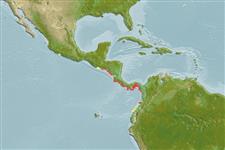>
Gobiiformes (Gobies) >
Microdesmidae (Wormfishes) > Microdesminae
Etymology: Cerdale: Greek, kerdoo, -oos, ous = the wary one, the wily one or the fox. Fishes of Alaska, Jordan and Evermann, 1898; personnal communication of Catherin W. Mecklenburg, California Acad, of Sciences.
More on authors: Jordan & Gilbert.
Environment: milieu / climate zone / depth range / distribution range
Ecología
marino demersal; rango de profundidad 0 - 1 m (Ref. 11482), usually 0 - 1 m (Ref. 11482). Tropical
Eastern Central Pacific: Costa Rica to Colombia.
Tamaño / Peso / Age
Maturity: Lm ? range ? - ? cm
Max length : 7.5 cm TL macho / no sexado; (Ref. 11482)
Inhabits shallow rocky coasts, including tide pools. Feeds on zooplankton and tiny benthic crustaceans.
Life cycle and mating behavior
Madurez | Reproducción | Puesta | Huevos | Fecundidad | Larva
Allen, G.R. and D.R. Robertson, 1994. Fishes of the tropical eastern Pacific. University of Hawaii Press, Honolulu. 332 p. (Ref. 11482)
IUCN Red List Status (Ref. 130435: Version 2024-1)
Threat to humans
Harmless
Human uses
Herramientas
Special reports
Download XML
Fuentes de Internet
Estimates based on models
Preferred temperature (Ref.
123201): 27.3 - 29.1, mean 28.2 °C (based on 110 cells).
Phylogenetic diversity index (Ref.
82804): PD
50 = 0.5312 [Uniqueness, from 0.5 = low to 2.0 = high].
Bayesian length-weight: a=0.00389 (0.00180 - 0.00842), b=3.12 (2.94 - 3.30), in cm total length, based on all LWR estimates for this body shape (Ref.
93245).
Nivel trófico (Ref.
69278): 3.5 ±0.47 se; based on food items.
Fishing Vulnerability (Ref.
59153): Low vulnerability (10 of 100).
